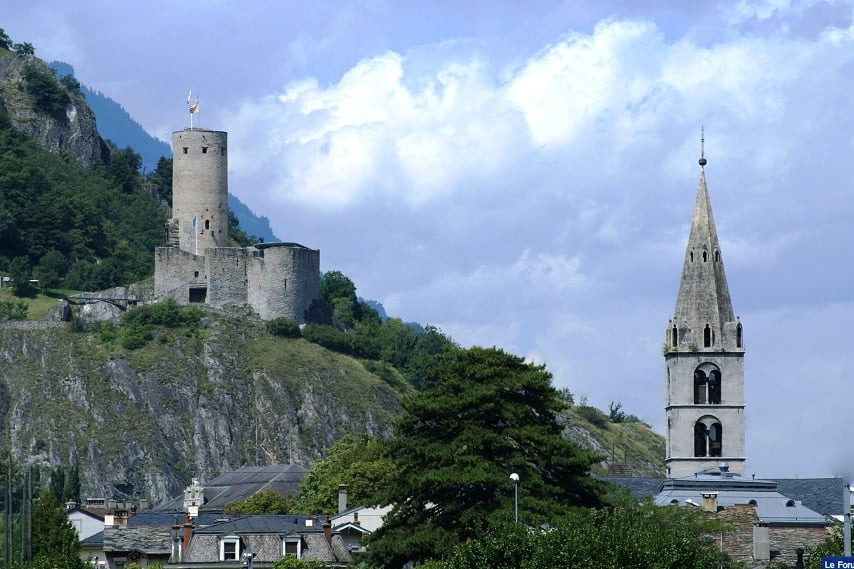Chamonix is located at a crossroads in the Alps, nestled in the corner of France between Italy and Switzerland. Thanks to this convenient location, there are many attractive destinations which are within easy reach for a day trip, including Courmayeur, Aosta and Turin in Italy, and Annecy. In winter, you can also enjoy ski away days to Courmayeur, our neighbouring French town of Megève, and Verbier in Switzerland.
Also in Switzerland, and accessible all year round, is the city of Martigny. In the French-speaking Valais region of Switzerland, Martigny is the first city that you come to if you exit the Chamonix valley at the top, past Vallorcine. Martigny is a great choice for a day trip from Chamonix and can be easily accessed by car or by train.
Chamonix-Martigny day trip by train
The train ride from Chamonix to Martigny is, quite simply, spectacular. Join the local train, the Mont Blanc Express, anywhere in the Chamonix valley and ride it to the end of the line in Vallorcine. From the huge windows – specially designed to show off the views – take in the iconic peaks of Chamonix.
Top tip: Make sure you sit in the middle carriage on the train, as this has the extra high windows for views of the mountains.
As the train passes Les Praz, the Drus soar up on your right-hand side; the Grands Montets area is also visible on the same side as you pull into Argentière; from Montroc station admire the glacier du Tour; before you come into the terminus at Vallorcine. (Montroc is also the highest altitude station on the French sector of the line, at 1364m.)
Here, step off the train, and after a short wait, get onto an identical train on the adjacent platform to whisk you off over the border and into Switzerland.
At the first stop – Le Châtelard Frontière – look out onto the right-hand side to see the original station building and adjacent restaurant – and keep an eye out for the same beautiful style of old-fashioned station house all the way along the line.
From Le Châtelard, the train will continue climbing to its highest altitude in Switzerland of 1224m, at Finhaut. Look out over to your right on this section for beautiful views of the Glacier du Trient.

Copyright OT Vallee de Chamonix Salome Abrial
The route from here cuts along the side of a deep gorge-like valley, weaving in and out of trees, with plunging views down on the right. The depths of the valley are striking, with some sections where the bottom is not even visible.
Instead, gaze across the valley to some of the hamlets perched in tiny clearings in the forest, and imagine the small communities which live up there.
Top tip: Take your seat on the right side of the train for the best views of the valley that the train will be traversing. It’s fairly vertiginous, though, so if you don’t have a good head for heights, stick to the left!
You’ll pass through small stations and request stops as the train descends gently to Salvan at 934m altitude. Keep your eyes peeled, as wildlife is sometimes surprised by the passing train and passengers have been known to glimpse chamois and eagles in or above the forest.
Upon leaving Salvan, the train begins an impressive rapid descent, losing over 450m to reach the large and wide valley floor where Martigny is located. For this final stretch and if there are seats available, you may want to move to the other side of the train as the views open out on to the plains below.
You’ll arrive at Martigny station, within a short walking distance of many of the local attractions. See a virtual video of the journey from Martigny to Le Châtelard Frontière at the bottom of the page.
Good to know
The journey takes 1 hour 42 minutes from Chamonix centre SNCF to Martigny, and slightly less (1 hour 26 minutes) on the way back. There are about a dozen connections each day, with the earliest leaving Chamonix centre at 7.54am and the latest departure at 7.54pm. For the return journey, the first train departs Martigny at 7.46am and the last train back to Chamonix is at 6.46pm.
Although visitors to Chamonix get free travel as far as Vallorcine with their guest cards (provided on arrival to Chamonix All Year guests), this is not valid if you are continuing your journey beyond Vallorcine. You’ll therefore need to buy a ticket from your starting station in Chamonix valley to Martigny. Cost is approx 29€ per adult for a return ticket.
Places to stop along the way: train Chamonix-Martigny
On the Swiss section of the train line, there are several attractions if you don’t want to go all the way for a Martigny day trip. Read on to find out what Martigny has to offer if you do travel all the way to the end of the Mont Blanc Express line.
Le Châtelard VS: Vertic’Alp Emosson – funicular trains and Emosson Dam
Finhaut: public bus links to Emosson Dam
Le Trétien: Gorges du Tiège
Les Marécottes: zoo / swimming pool, Télécabine de la Creusaz
Salvan: Barrage de Salanfe, Gorges du Dailley
Vernayaz: Gorges du Trient
Chamonix-Martigny day trip by car
The road route for a Martigny day trip follows the Chamonix valley as far as Vallorcine but, once over the border and past Le Châtelard, it diverges from the train’s path and takes a different route which dates from 1957.
First, the road passes through Trient, one of the stops on the Tour du Mont Blanc, with its iconic pink church, before climbing to the Col de la Forclaz. The col, or mountain pass, has featured on the Tour de France route and is at an altitude of 1527m.
From this high point, you’ll continue on a beautiful mountain road, winding down 4 hairpin bends before a long straight section gives you spectacular views over the plain where Martigny is located. The road also passes through some of the vineyards which the Valais region is famous for.

About Valaisan wines: The climate and soil quality of the Valais region ensures that the vineyards here produce a wealth of unique wines (one-third of all Swiss wines are produced in this region). The high mountains of the Alps provide protections and guarantee a dry climate compared to the other Swiss wine-producing regions, while the Foehn warm wind phenomenon which is common in the mountains also helps. The soils are diverse allowing a wide range of grape varieties to be cultivated, thanks to the geological history, receding glaciers and deposits from the Rhône and alpine torrents.
Passing through the vineyards, you’ll turn round a final hairpin bend, before coming in to the entrance to Martigny city at a roundabout.
Good to know
The journey driving from Chamonix centre to Martigny takes just under one hour. If you don’t venture further than Martigny, and you stay on local roads, then there are no tolls or road taxes to pay, and you won’t need a Swiss vignette.
The road from Chamonix to Martigny is open 365 days of the year. Short-term road closures may occur after snowfall in winter, while the road is cleared for access again. Check for road closures on the Chamonix Tourist Office website.
Places to stop along the way: driving Chamonix-Martigny
If you have made an early start on your Martigny day trip from Chamonix, and you have time for a diversion along the way, then here are a couple of our recommendations:
Emosson dam – it’s just a short 15 minute (one-way) diversion to drive up from the main road to the Emosson dam, if you haven’t got time to ride the funiculars. The views are beautiful and you can recce the location for a future visit to the funiculars or to hike up and see the dinosaur footprints.
Col de la Forclaz – if you’re an avid follower of the Tour de France, then don’t miss the chance to stop off at the top of this col. There’s a restaurant for refreshments, or if you’re feeling particularly energetic, you could strike out on the Bisse du Trient walk recommended in our family hiking guide.
What to visit on a Martigny day trip
Upon arrival in Martigny, you’ll want to get your bearings. The train station is located to the north-east of the city, while the road brings you in at the south-west corner.
The city centre is fairly compact and it’s easy to navigate and walk around. The original town centre has plenty of character, though outside of this zone, Martigny quickly becomes residential and fairly uninspiring.
The Place Centrale is a good place to head for lunch, with a range of options to suit different budgets and plenty of sunny terraces.
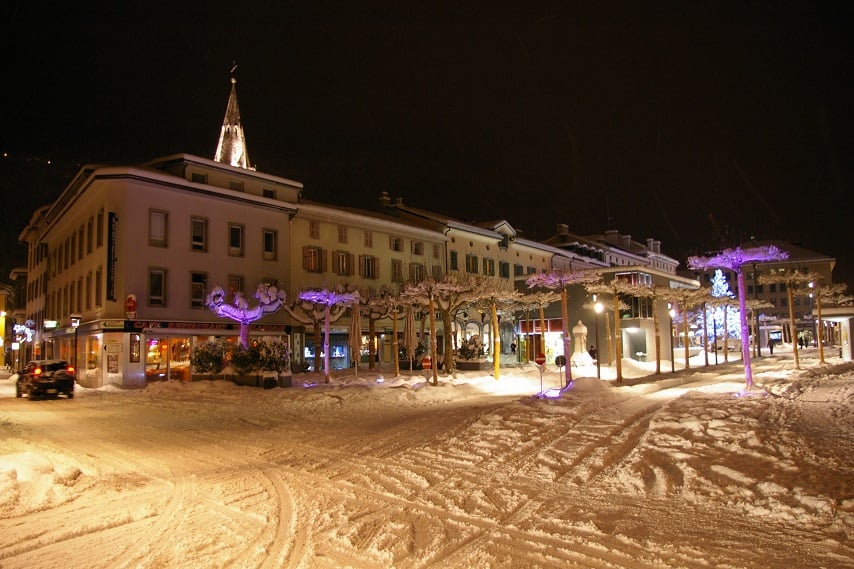
Martigny is a great cultural destination, and also has a family appeal – as well as the brilliant train journey to get there, there are Roman ruins and St Bernard dogs to discover too. Here are some of the main attractions to head for.
Fondation Gianadda
The Pierre Gianadda Foundation is a cultural complex in Martigny city centre and its permanent exhibitions offer something for everyone. It is definitely well worth a visit and is a good activity option for a rainy day in Chamonix.
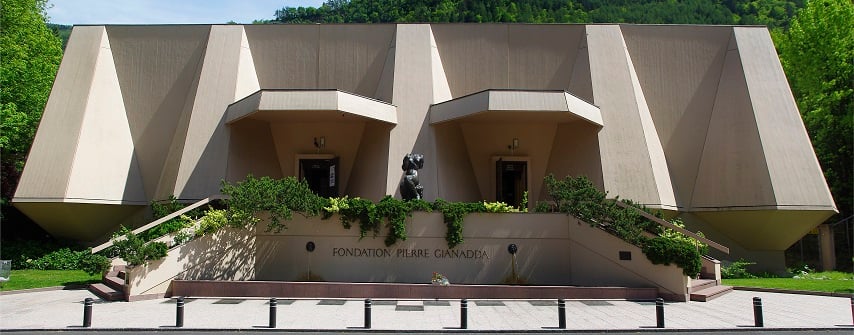
Automobile museum: 50 working vintage cars dating from 1897 to 1939 are on display, including some which are unique in the world!
Sculpture garden: modern sculptures sit alongside Roman ruins and water features in a beautiful park.
Gallo-Roman museum: the Foundation is built around the remains of a Celtic temple, presenting the most significant archaeological finds made in Martigny.
The Foundation also hosts temporary exhibitions of artworks by some of the most celebrated artists in the world. Past exhibitions have seen works by Rodin, Degas, Manet, Kandinsky, Picasso, Van Gogh and Matisse, to name only a few…
Open every day. June-November 9am-7pm. November-June 10am-6pm.
Rue du Forum 59, 1920 Martigny, Switzerland
Adult entrance costs approx. 16.50€ / 20 CHF, with discounts available for seniors, children and families. If you have time to visit the St Bernard Dogs Museum as well (see below), your ticket for the Fondation Gianadda will give you a 30% discount.
Roman ruins
Martigny was known as Octodure during Roman times, a moderately important settlement located on the axis between Rome, France and England. There were a number of significant public and private buildings in Roman Octodure, the ruins of which can still be explored today on a walking tour of the city.
The most significant sites are clustered together on the south side of the city – there is an open-air park where the Roman baths have been excavated, with part of the complex preserved underneath the modern ice rink building. There’s also a Roman private house on the other side of the park which has been excavated and preserved underneath a parking area.
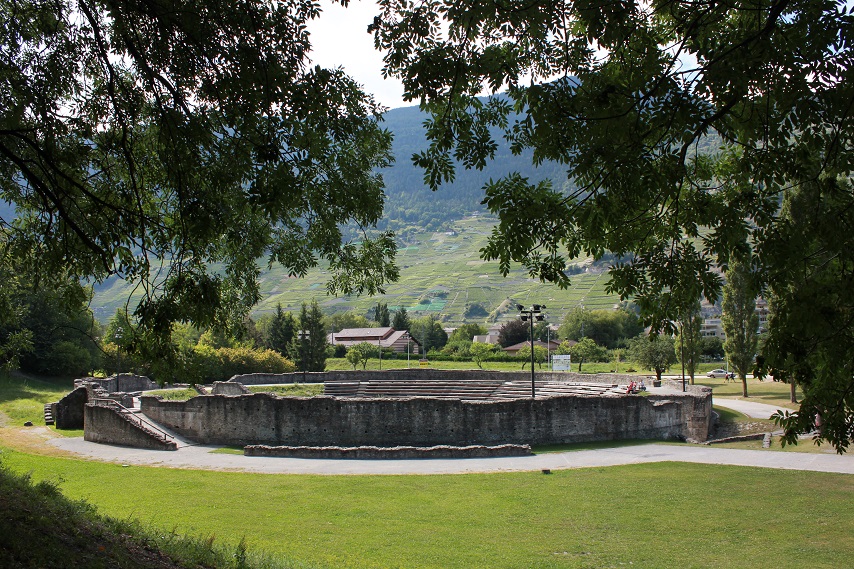
A pedestrian itinerary takes you through the ancient site of Octodure, via a temple and additional baths area, past the remains of a Roman road, to the amphitheatre. Once these ruins have whet your appetite, head across the road again to the Fondation Gianadda for some of the most significant finds.
The website of the Fondation Gianadda has a great map which shows the archaeological sites to visit, as well as other points of interest for a Martigny day trip (unfortunately not available on an English-language page).
Barryland – Museum & St Bernard dogs
History of St Bernards
The St Bernard breed of dogs, a national symbol of Switzerland, takes its name from the Col du Grand St-Bernard, the mountain pass at 2,469m which links Martigny with Aosta in Italy.
Thanks to the col’s geographical position at a low point on the ridge between Mont Blanc and Monte Rosa, it is one of the most ancient mountain passes in the Western Alps, going back to the Bronze Age.
A hostel and monastery, the Great St Bernard Hospice, was founded in the 11th Century at the col, and it was here that St Bernard dogs were bred for use in rescue operations, from the 17th Century. The dogs were bred to a large size, to allow them to traverse deep snow, and popular culture usually depicts them carrying small barrels of brandy around their necks for its supposed medicinal purposes, although this does not seem to have any historical basis.
A tunnel opened in 1964, making for a more convenient route between Martigny and Aosta. Combined with modern technology advances, this meant that the dogs were no longer needed for rescue operations. The Fondation Barry which owns Barryland bought the kennels and took over the breeding of the dogs. A number of St Bernards are brought to the monastery each summer.
The mission of the foundation is to continue to breed St Bernards in their place of origin, as well as to educate generations to come about the history and myths of the dogs.
About the St Bernard dogs museum in Martigny
The museum is spread out over 3 floors. The ground floor is arguably the main attraction with the kennels and opportunities to meet the dogs and take photos (donations expected). You can also see them being fed and groomed, and watch them play or sleep. Feeding of the dogs happens at 5.15pm, and photo opportunities are every hour, at half past.

©Barryland
On the first floor is the museum itself, with plenty of information on the history of the breed, the hospice, as well as the mountain pass and tunnel. The information is in French, but translation folders are available at the entrance, and there are also QR codes throughout the exhibition which you can flash with your smartphone to see translations.
The second floor offers a great interactive playroom for kids!
At different times of the year, hikes with the St Bernards are organised, and the programme can be found on their website.
Open 363 days of the year (closed Christmas Eve and Christmas Day). 10am-6pm every day.
Adults 12 CHF, with discounts available for seniors, children and families. See above for info on discounts with a ticket for Fondation Gianadda.
Barryland, Rue du Levant 34, 1920 Martigny, Switzerland.
Château de la Bâttiaz
This castle is perched on the hillside in what was a perfect strategic location for the defence of the valley and St Bernard pass approach in the 13th Century. The castle was burned down in the 16th Century, and though it was never rebuilt, the ruins were restored in 1980 to allow visitors to return.

It’s possible to visit the castle and their collection of catapults and canons. If you want a more authentic and immersive experience, the historic building is now also home to a medieval restaurant.
The dishes served are authentic, reproduced using local products provided by local farmers and traders. With seasonal vegetables, Valaisan wines only, and traditional knowledge, your meal is sure to be unforgettable. Get in touch ahead of your visit to reserve a table.
The castle is open May-October. (If you see the blue flag flying from the top of the tower, the castle is open to welcome you!)
- May / June / September / October: Wednesday & Sunday 11am-6pm; Friday & Saturday 11am-midnight. Closed Monday & Tuesday.
- July & August: Tuesday-Saturday 11am-midnight. Sunday 11am-6pm. Closed Monday.
The walk up to the castle takes 10 minutes from the bottom of the road (approx 20 minutes from the train station or Place Centrale).
Case Postale 58, 1920 Martigny, Switzerland
Pont de la Batiaz
Close to the castle’s access road is this pretty and unusual bridge, straddling the river Dranse. A bridge has stood at this site (or close to it) since the 14th Century, and the current wooden covered bridge has been standing since 1829.
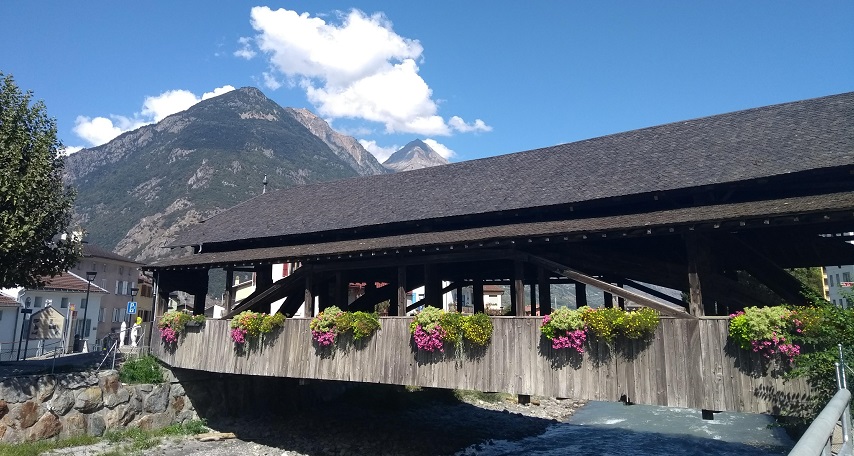
Rue de la Batiaz, Martigny 1920, Switzerland
No website, some info on TripAdvisor
Final top tips for a Martigny day trip
As you’re going to be travelling to Switzerland, don’t forget to take your passport!
Switzerland is also outside the Eurozone, so if you have Swiss Francs you should bring them along. Most restaurants and attractions will accept cash payments in euros, but will give change in Swiss Francs. (You can always spend this change in Geneva Airport on your way home.)
Featured image at top of page ©Martigny Tourisme


